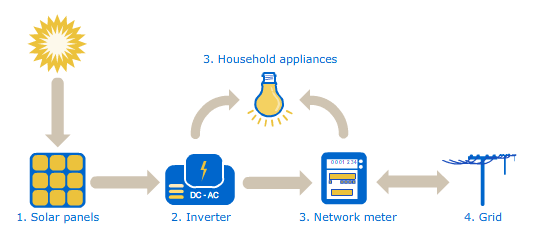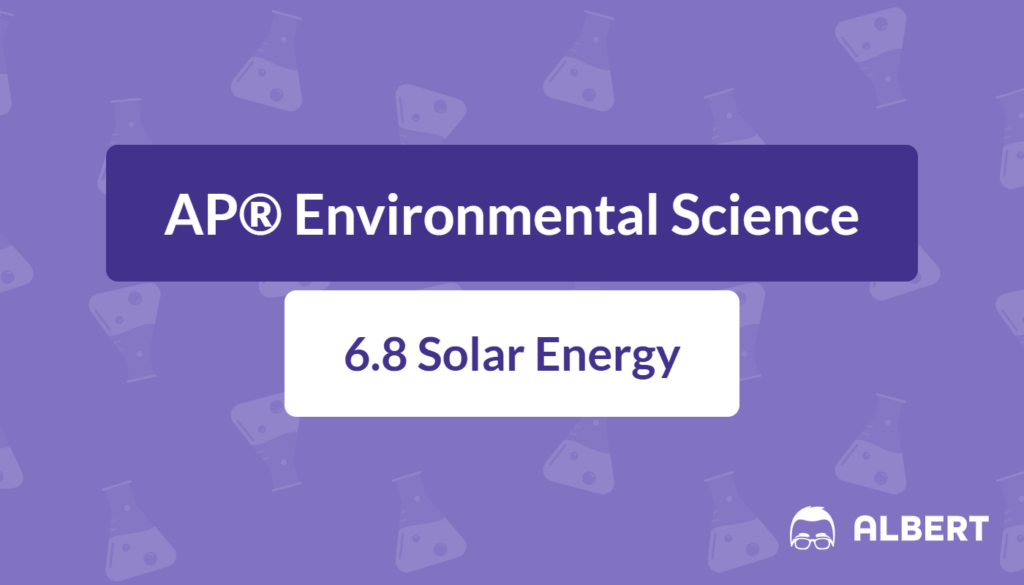What We Review
Introduction
Solar energy stands out as one of the most promising forms of renewable energy today. It directly harnesses the sun’s power and produces little to no harmful emissions. Moreover, it helps reduce dependence on fossil fuels, which are linked to carbon cycle disruptions and climate change. In AP® Environmental Science, solar energy connects to core themes of sustainable resource management and environmental impact. Therefore, understanding how does solar power work and why it matters is essential for examining potential solutions to challenges posed by a growing global population and increasing energy demands.
This article explores the fundamentals of solar energy, its mechanisms, and the advantages and disadvantages accompanying its use. In addition, it highlights the environmental impacts and concludes with important vocabulary to help students become more confident in their knowledge of solar power.
What Is Solar Energy?
Solar energy is the radiant light and heat that come from the sun. Although the sun is approximately 150 million kilometers from Earth, its light travels that distance in roughly eight minutes. Consequently, this light can be captured and converted into usable forms of energy on our planet.
In environmental science, solar power is classified as a renewable energy source because the sun continually emits energy every day. It is also considered clean energy since it does not directly produce carbon dioxide or other significant greenhouse gases when generating electricity. Therefore, many countries invest in solar power to reduce their carbon footprints and to slow changes in the climate.
How Does Solar Power Work?
Solar power systems focus on capturing sunlight and transforming it into electricity or heat for human use. There are three major categories of solar energy systems:
- Photovoltaic Solar Cells
- Active Solar Energy Systems
- Passive Solar Energy Systems
Each system has a unique approach to converting solar radiation into useful energy.

Photovoltaic Solar Cells
Photovoltaic (PV) solar cells turn sunlight directly into electricity. These are the panels often seen on rooftops or in large solar farms. They are typically made from semiconducting materials—commonly silicon—that absorb photons from sunlight.
How Do Photovoltaic Solar Cells Work?
- Sunlight reaches the PV panel, carrying photons that excite electrons within the layers of the semiconducting material.
- An electric field inside the PV panel forces these excited electrons to move in a specific direction.
- This movement of electrons creates an electric current.
- Wires connected to the panel then carry this current to a location where it can be used or stored in a battery.
Example: Rooftop Solar Panels
Consider a house that uses rooftop solar panels. When sunlight hits the panels, the electrons inside the PV cells flow, creating a direct current (DC). An inverter next to the panels converts the DC into alternating current (AC), which most household appliances require. Excess electricity can sometimes be sold back to the local grid, thereby offsetting energy costs.
Active Solar Energy Systems
Active solar energy systems rely on mechanical and electrical equipment to collect, store, and distribute solar heat. These systems often use a fluid—such as water or antifreeze—to absorb energy from the sun and circulate it through pipes.
How Do Active Solar Energy Systems Work?
- The sun’s rays heat liquid inside a series of tubes or panels (often called “solar collectors”).
- A pump or fan drives the heated fluid to a storage tank or heat exchanger.
- This stored heat can then be transferred to water for domestic hot water supply, or it can be directed into a heating system for a building.
Example: Solar Water Heaters
A home equipped with an active solar water heater uses solar collectors on the roof. During daylight, sunlight warms the fluid in the collectors. Next, a small pump circulates that fluid into a water storage tank. The stored heat keeps the household supply of water warm, reducing the need for conventional water heating methods. However, an auxiliary heater may still be necessary on cloudy days.
Passive Solar Energy Systems
Passive solar energy systems require no moving parts or electricity. Instead, they rely on building design features and the natural movement of heat and light. The goal is to allow sunlight into living spaces to capture heat in the winter, while limiting heat gain in the summer.
How Do Passive Solar Energy Systems Work?
- Large south-facing windows let in abundant sunlight.
- Materials like concrete floors or thick walls store heat, slowly releasing it, which helps regulate indoor temperatures.
- Overhangs or window shades block excessive sunlight during hot summer months to prevent overheating.
Example: A House with Large South-Facing Windows
Imagine a residence with expansive windows facing the midday sun. During winter, the lower angle of the sun’s rays lets in plenty of sunlight, warming interior surfaces. Those surfaces then release heat gradually throughout the day. Conversely, in summer, awnings or overhangs prevent the higher-angle sunlight from penetrating deeply inside, aiding temperature control without relying heavily on air conditioning.
Advantages of Solar Energy
Solar energy offers multiple benefits, especially for communities aiming to achieve sustainable growth and energy security. Furthermore, it introduces fewer environmental hazards compared to traditional fossil fuels. Several advantages include:
- Clean Energy: Solar power generates minimal carbon dioxide emissions. Therefore, it helps reduce the greenhouse effect and limits disruption to the carbon cycle.
- Energy Independence: Societies that install solar panels can reduce their reliance on imported fuel, improving energy security.
- Economic Growth: The solar industry often boosts local economies by creating installation and maintenance jobs.
- Scalability: Solar systems can be as small as a single rooftop panel or as extensive as a utility-scale solar farm. This flexibility means different communities can adapt solar projects according to their needs.
Disadvantages of Solar Energy
Despite its benefits, solar energy comes with a few drawbacks that may limit widespread adoption:
- Initial Costs: The purchase and installation of solar equipment can be expensive. However, government incentives or tax credits may offset some costs in certain regions.
- Intermittency: Solar power generation depends heavily on sunlight. Cloudy or rainy days reduce output, and energy storage solutions can be costly.
- Geographic Limitations: Areas with fewer sunny days might not generate enough energy to justify the investment.
- Land Use: Large solar farms require significant space. Consequently, they can disrupt habitats and compete with agriculture or natural ecosystems for land.
The Environmental Impact of Solar Energy
Solar energy systems generally have a low environmental impact when operating because they emit negligible amounts of greenhouse gases. They also avoid the air pollution associated with burning fossil fuels. Therefore, they contribute to cleaner air and help slow climate change.
However, large-scale solar farms require extensive land areas, which can force wildlife to relocate. In addition, the manufacturing of solar panels and batteries involves mining raw materials, such as silicon and lithium. This mining process can affect local ecosystems if not managed sustainably. Overall, solar power has a far smaller environmental footprint than most fossil fuel–based energy sources, but it remains necessary to consider conservation strategies when developing new projects.
Conclusion
Solar energy represents a reliable and efficient pathway for reducing dependence on fossil fuels. It supports lower carbon emissions, promises higher energy security, and stimulates job growth in the renewable energy sector. Yet, solar technology faces challenges related to cost, storage, and land requirements. Therefore, researchers, policymakers, and industries continue to improve solar technologies to make them more accessible and eco-friendly.
Solar energy should be viewed as a part of the larger picture of sustainable resource management. It offers a solution that can help mitigate climate change while simultaneously providing new economic opportunities. Ultimately, exploring solar energy encourages an understanding of how society can balance economic growth and environmental stewardship through clean, renewable energy sources.
Key Vocabulary
- Photovoltaic Solar Cells: Devices made of semiconducting materials that directly convert sunlight into electricity.
- Active Solar Energy: Systems that rely on mechanical equipment, such as pumps or fans, to capture and circulate solar heat.
- Passive Solar Energy: Systems that use building design and natural heat transfer processes instead of mechanical devices.
- Renewable Energy: A category of energy sources (e.g., solar, wind, geothermal) that naturally replenish over relatively short time frames.
- Carbon Footprint: The total amount of carbon dioxide and other greenhouse gases produced directly or indirectly by an individual, organization, or product.
- Solar Radiation: Electromagnetic energy emitted by the sun that can be converted into heat or electricity.
Sharpen Your Skills for AP® Environmental Science
Are you preparing for the AP® Environmental Science test? We’ve got you covered! Try our review articles designed to help you confidently tackle real-world AP® Environmental Science problems. You’ll find everything you need to succeed, from quick tips to detailed strategies. Start exploring now!
- AP® Environmental Science: 6.5 Review
- AP® Environmental Science: 6.6 Review
- AP® Environmental Science: 6.7 Review
Need help preparing for your AP® Environmental Science exam?
Albert has hundreds of AP® Environmental Science practice questions, free response, and full-length practice tests to try out.








